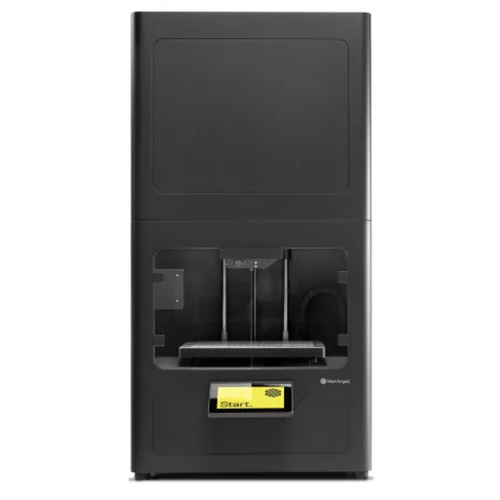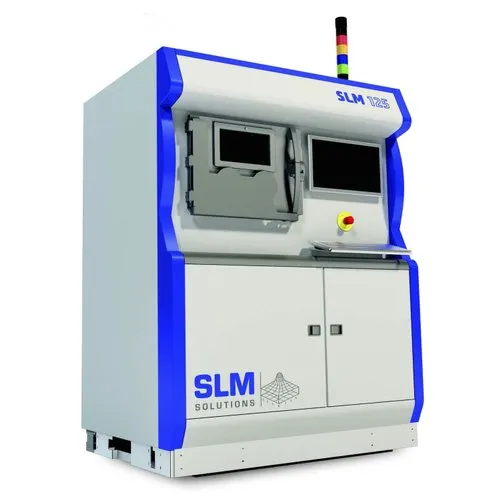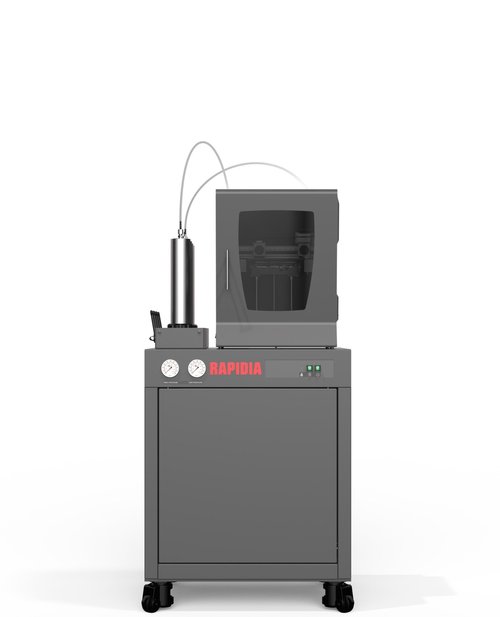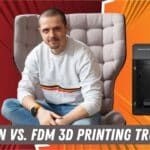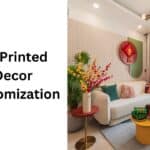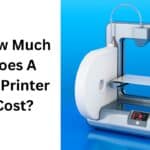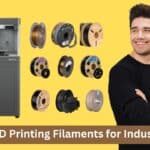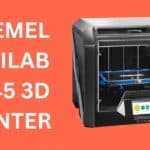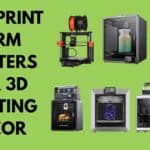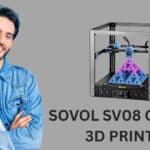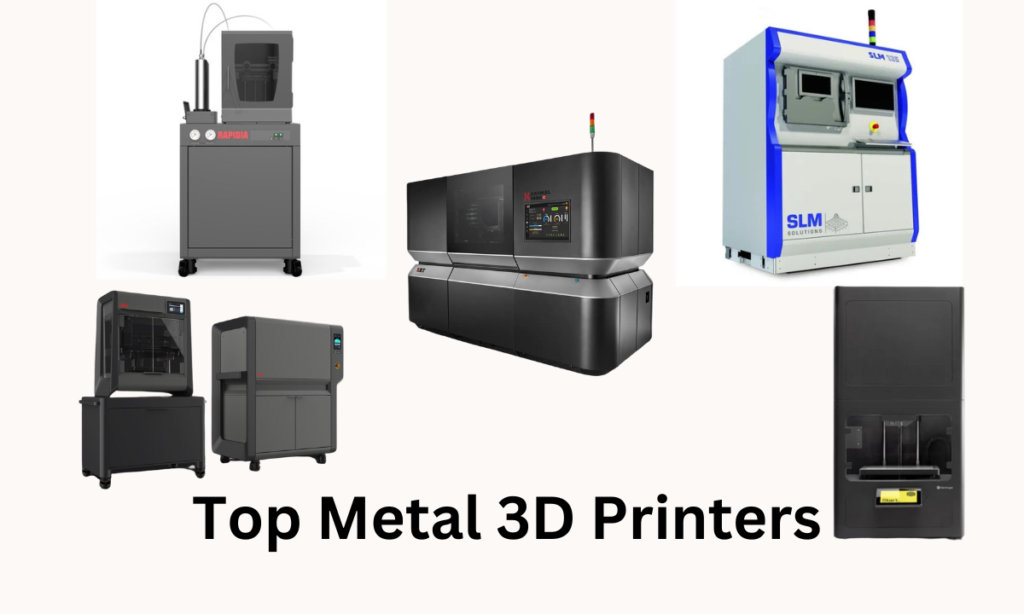
In recent years, 3D printing has revolutionized industries around the world, and metal 3D printing has become a powerful tool for businesses looking to innovate.
Affiliate Disclosure
We participate in Amazon affiliate programs, earning fees from qualifying purchases via links at no extra cost to you. It’s how we keep this blog rolling and my 3D printers buzzing with fresh filament for reviews like this one!
Metal 3D printers allow companies to produce strong, complex parts quickly, reducing time and costs for prototyping and small-scale manufacturing. Whether you’re in aerospace, automotive, healthcare, or manufacturing, metal 3D printers can offer an efficient solution to traditional metalworking methods.
In this guide, we’ll explore the top metal 3D printers for 2025, with a focus on models suited for the USA market. We’ll cover the pros and cons, best uses, and technical specs for each printer. Let’s dive in!
What is Metal 3D Printing?
Metal 3D printing, also known as additive manufacturing, involves creating three-dimensional metal parts layer by layer. Unlike traditional manufacturing, where material is cut away, 3D printing builds objects from the ground up using metal powders, resins, or filaments.
Overview of 3D Metal Printers
3D metal printers utilize techniques such as Selective Laser Melting (SLM), Direct Metal Laser Sintering (DMLS), and Metal Binder Jetting to fuse metal powders layer by layer into solid objects. These technologies allow for high precision and the ability to work with a wide range of metals, including stainless steel, titanium, aluminum, and cobalt-chrome alloys.
Key Technologies
- Selective Laser Melting (SLM):
- Uses a high-powered laser to melt and fuse metal powder together.
- Ideal for producing dense and strong parts.
- Commonly used in aerospace, automotive, and medical industries.
- Direct Metal Laser Sintering (DMLS):
- Similar to SLM but typically uses a different type of laser and can produce parts with slightly different properties.
- Allows for the creation of complex geometries with excellent mechanical properties.
- Metal Binder Jetting:
- Involves depositing a binder material onto metal powder layers, which are then sintered in a furnace to create solid parts.
- Generally faster than laser-based methods but may require additional post-processing.
Benefits of 3D Metal Printers
- Design Flexibility: Allows for the creation of complex shapes and designs that traditional methods cannot achieve.
- Reduced Material Waste: By building up rather than cutting away, it uses only the necessary material.
- Cost-Effective Prototyping: Great for creating prototypes without investing in costly molds or dies.
- Shorter Production Times: Reduces the time from design to production, speeding up product development cycles.
Applications of 3D Metal Printers
3D metal printers are used in various industries, including:
- Aerospace: For lightweight components that require high strength-to-weight ratios.
- Medical: Custom implants and surgical tools tailored to individual patients.
- Automotive: Production of complex engine components and prototypes.
- Tooling: Manufacturing specialized tools and fixtures.
Top 5 Metal 3D Printers for 2025
Here’s a look at some of the top metal 3D printers available for 2025 in the USA. We’ll include a quick comparison table and then go into details for each model.
| Printer Name | Price Range | Build Volume | Material Compatibility | Technology |
|---|---|---|---|---|
| Markforged Metal X | $99,500 | 300 x 220 x 180 mm | 17-4PH Stainless Steel, A2 and D2 Tool Steel, Inconel 625, Copper, H13 Tool Steel | Metal FFF |
| Desktop Metal Studio System 2 | $110,000 | 300 x 200 x 200 cm | Various metals, including H13 Tool Steel | Bound Metal Rod Extrusion |
| XJet Carmel 700 | $599,000+ | 501 × 140 × 200 mm | Ceramic, Metal | NanoParticle Jetting™ (NPJ) |
| SLM Solutions SLM 125 | $400,000-$500,000 | 125 x 125 x 125 mm | Various metals, including Stainless Steel and Aluminum | Laser Sintering |
| Rapidia Conflux 1 | $99,000+ | 200 x 240 x 150 mm | Various metals, including Stainless Steel | Metal Paste Deposition, Independent Dual Extruder |
This table provides a clear comparison of the different options available for metal additive manufacturing in the USA, highlighting their unique features and capabilities.
Top Metal 3D Printers for 2025
Markforged Metal X
The Markforged Metal X 3D printer represents a significant advancement in the field of metal additive manufacturing, offering a unique approach to producing high-quality metal parts. Below is a detailed review that covers its design, functionality, performance, and overall value in various industrial applications.
Overview
The Metal X is designed for fabricating complex metal components using a proprietary process known as Atomic Diffusion Additive Manufacturing (ADAM). This technique involves binding metal powder with polymers, allowing for safer handling compared to traditional metal printing methods that utilize loose powders and lasers. The Metal X system includes not just the printer but also essential post-processing equipment: the Wash-1 for debinding and either the Sinter-1 or Sinter-2 for sintering the printed parts.
Build Quality and Design
The build quality of the Metal X is robust, featuring a compact design that integrates well into professional environments. Its construction utilizes high-quality materials, ensuring durability and reliability. The user-friendly interface, highlighted by an intuitive touchscreen, simplifies operation, making it accessible even for those new to metal 3D printing.
Technical Specifications
| Feature | Specification |
|---|---|
| Build Volume | 11.8″ x 8.7″ x 7.1″ (300mm x 220mm x 180mm) |
| Layer Thickness | 50 microns to 125 microns |
| Weight | 165 lbs (75 kg) |
| Printing Process | Bound Powder Filament |
Material Compatibility
One of the standout features of the Metal X is its versatility in material selection. It supports various metals such as stainless steel, tool steels, and Inconel. However, it’s important to note that users are limited to pre-approved materials from Markforged, which may restrict some design ambitions but ensures optimal print quality and consistency.
Print Accuracy and Surface Finish
The Metal X excels in producing parts with impressive accuracy and surface finish. It meets industry benchmarks for metal 3D printing, capable of reproducing intricate geometries with minimal need for post-processing—a common challenge in additive manufacturing. Users have reported that the mechanical properties of printed parts are comparable to those produced through traditional manufacturing methods, making it suitable for end-use applications across various sectors like aerospace and automotive.
Performance and Throughput
While the Metal X offers significant advantages in terms of safety and ease of use, some users have expressed concerns regarding print speed and overall throughput. The total time from printing to sintering can be lengthy—often exceeding 28 hours depending on part complexity and size—leading some to question its efficiency compared to other systems available on the market. Additionally, there are reports of size variations post-sintering, which could impact precision-critical applications.
Cost Considerations
The initial investment for the Markforged Metal X is substantial, typically starting around $99,500. However, it is positioned as a more affordable alternative compared to traditional direct metal laser sintering (DMLS) systems, which often require extensive safety measures and infrastructure due to their use of loose powders. The Metal X’s approach reduces operational costs related to hazardous material handling.
Conclusion
In summary, the Markforged Metal X 3D printer stands out as an innovative solution for producing high-strength metal parts in a safer and more user-friendly manner than traditional methods. While it offers excellent print quality and material versatility, potential buyers should weigh its costs against performance metrics like print speed and dimensional accuracy. For industries looking to integrate metal additive manufacturing into their workflows without extensive safety concerns or infrastructure upgrades, the Metal X presents a compelling option worth considering.
Desktop Metal Studio System 2
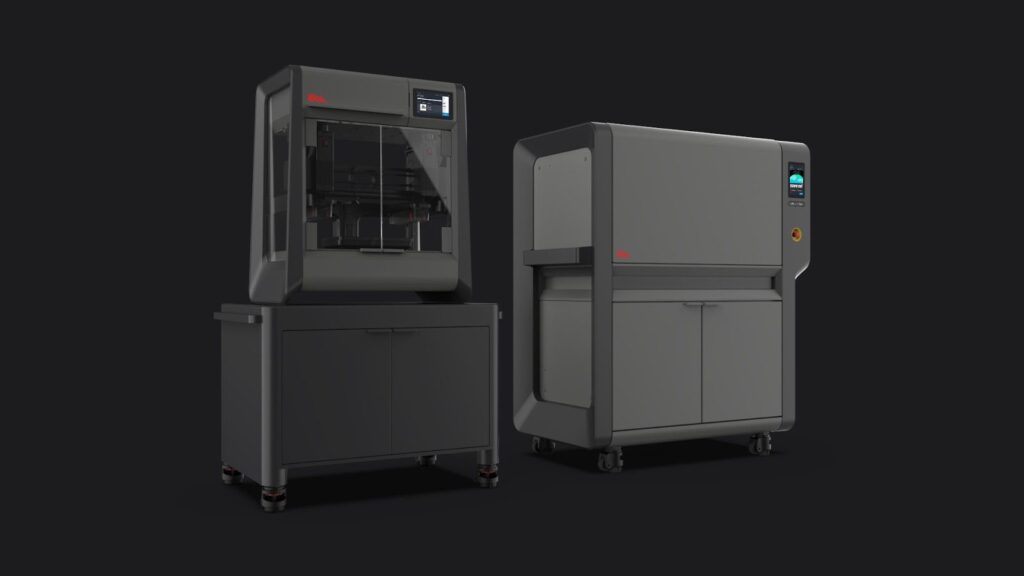
The Desktop Metal Studio System 2 is a cutting-edge metal 3D printer designed for office environments, making it accessible for small to medium-sized businesses looking to produce high-quality metal parts. This review evaluates its design, functionality, performance, and overall value in the additive manufacturing landscape.
Overview
Launched in early 2021, the Studio System 2 builds upon its predecessor, the Studio System+, by introducing a streamlined two-step process that significantly simplifies metal printing. This system utilizes Desktop Metal’s proprietary Bound Metal Deposition (BMD) technology, which combines metal powder with a polymer binder, eliminating the need for loose powders and lasers. This innovation not only enhances safety but also makes the system more user-friendly for non-expert users.
Design and Build Quality
The Studio System 2 features a compact design that fits comfortably in office settings while maintaining robust build quality. Its dimensions are approximately 948 x 823 x 529 mm and it weighs around 97 kg, making it manageable yet substantial enough for industrial applications. The heated build chamber (up to 70°C) contributes to improved print quality and surface finish, while the intuitive touchscreen interface simplifies operation.
Technical Specifications
| Feature | Specification |
|---|---|
| Build Volume | 300 x 200 x 200 mm |
| Layer Height | 50 – 300 microns |
| Max Build Weight | 6.5 kg |
| Printer Dimensions | 948 x 823 x 529 mm |
| Weight | 97 kg |
Performance and Print Quality
The Studio System 2 is designed for producing complex geometries with high accuracy and excellent surface finishes. The new print profiles and materials enhance part quality while minimizing trial-and-error during the printing process. Users have reported that parts produced exhibit densities and mechanical properties comparable to traditional casting methods, meeting or exceeding industry standards set by the Metal Powder Industries Federation (MPIF).
Material Compatibility
Initially launched with support for 316L stainless steel, the system is expected to expand its material offerings, including additional alloys like 17-4PH stainless steel and H13 tool steel. The ability to handle diverse materials makes it suitable for various applications across industries such as automotive, aerospace, and consumer products.
Software Integration
Desktop Metal’s Fabricate software enhances the user experience by automating the workflow from printing to sintering. It allows users to customize over 90 print settings while generating separable support structures that prevent issues during post-processing. This software integration is a significant advantage, streamlining operations and reducing the learning curve for new users.
Cost Considerations
The Studio System 2 is priced at approximately $110,000, which may be a considerable investment for smaller companies. However, this price point is competitive compared to traditional metal additive manufacturing systems that often require extensive infrastructure and safety measures due to their use of loose powders.
The XJet Carmel 700 is an innovative metal and ceramic 3D printing system that employs the proprietary NanoParticle Jetting (NPJ) technology, setting it apart from traditional powder-based methods. This review explores its design, capabilities, performance, and potential applications in various industries.
Conclusion
In conclusion, the Desktop Metal Studio System 2 represents a significant advancement in office-friendly metal additive manufacturing. Its innovative two-step process simplifies production while maintaining high-quality output suitable for end-use applications. While it requires a substantial investment, its capabilities in producing complex geometries with excellent mechanical properties make it an attractive option for businesses looking to leverage metal 3D printing technology without the complexities associated with traditional methods. Overall, the Studio System 2 is poised to empower design and engineering teams across various sectors to rethink their manufacturing strategies effectively.
XJet Carmel 700
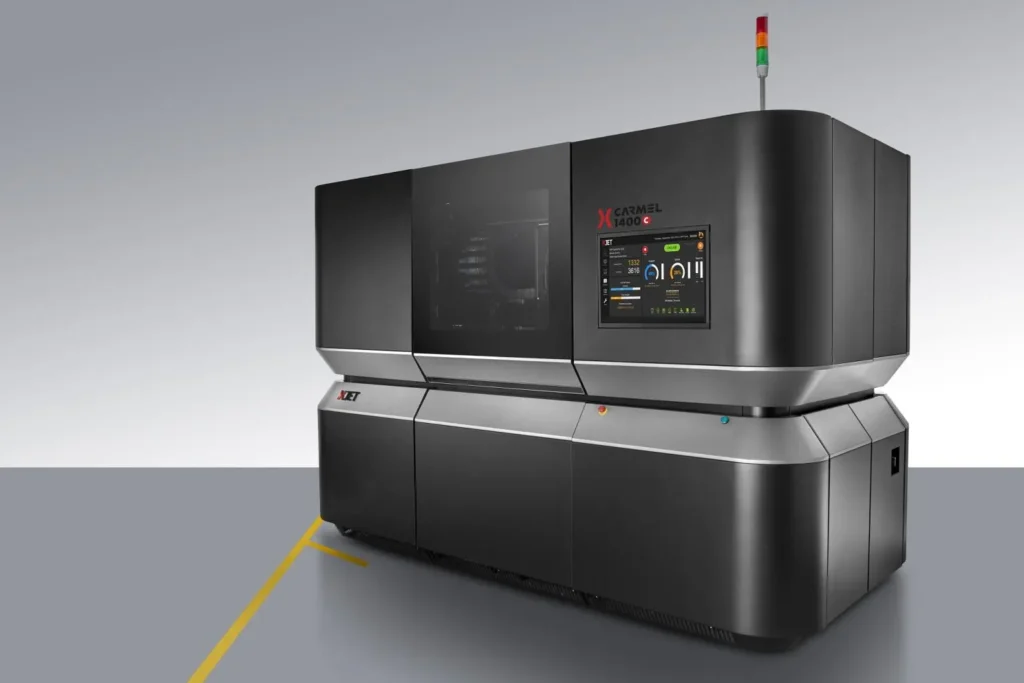
Overview
Launched as part of XJet’s line of advanced additive manufacturing systems, the Carmel 700 is tailored for producing high-quality metal and ceramic parts with intricate geometries. The NPJ technology utilizes liquid feedstock containing nanoparticles, which are jetted onto a build platform. This method eliminates the use of powders, enhancing safety and simplifying the printing process.
Design and Build Quality
The Carmel 700 boasts a compact footprint with a build volume of 501 mm x 140 mm x 200 mm, making it suitable for both prototyping and small-scale production. The printer’s dimensions are approximately 3100 mm x 1850 mm x 2120 mm, and it weighs around 2960 kg, reflecting its robust construction designed for industrial applications.
Technical Specifications
| Feature | Specification |
|---|---|
| Build Volume | 501 mm x 140 mm x 200 mm |
| Technology | NanoParticle Jetting (NPJ) |
| Materials | Ceramics, Metals (e.g., stainless steel) |
| Feedstock Format | Liquid |
| Approximate Price | Starting from $599,000 |
Performance and Print Quality
The Carmel 700 excels in producing parts with fine details and high surface quality. The NPJ process allows for layer resolutions that are difficult to achieve with traditional methods, enabling the creation of complex geometries with excellent dimensional accuracy. Users have reported that parts printed on the Carmel 700 exhibit high density and mechanical properties comparable to those produced through conventional manufacturing techniques.
Key Advantages
- High Precision: The NPJ technology allows for fine feature details and smooth surfaces without extensive post-processing.
- Safety: By using liquid feedstock instead of powders, the risk associated with handling hazardous materials is significantly reduced.
- Design Freedom: The ability to print complex geometries opens up new possibilities for product design across various sectors.
Applications
The Carmel 700 is particularly well-suited for industries that require high-precision components, such as:
- Medical Devices: Ideal for producing custom implants and dental applications due to its ability to create intricate designs.
- Aerospace: Suitable for lightweight components that demand high strength-to-weight ratios.
- Automotive: Can be used for prototyping parts and creating specialized tools.
Cost Considerations
With a starting price of approximately $599,000, the Carmel 700 positions itself as a premium solution in the metal additive manufacturing market. While this investment may be substantial for smaller companies, the potential for rapid prototyping and production efficiency can lead to significant long-term savings.
Conclusion
The XJet Carmel 700 represents a significant advancement in metal and ceramic additive manufacturing. Its unique NPJ technology offers unparalleled precision and safety compared to traditional powder-based systems. While the initial investment is considerable, its capabilities in producing high-quality, complex parts make it an attractive option for industries focused on innovation and efficiency. As companies continue to explore the possibilities of additive manufacturing, the Carmel 700 stands out as a powerful tool that can enhance production capabilities across various sectors.
SLM Solutions SLM 125
The SLM Solutions SLM 125 is an industrial-grade 3D printer that utilizes Selective Laser Melting (SLM) technology to produce high-quality metal parts. As one of the more compact models in SLM Solutions’ lineup, the SLM 125 is designed for research, development, and small-scale production, making it an appealing option for companies looking to enter the realm of metal additive manufacturing.
Overview
The SLM 125 features a build volume of 125 x 125 x 125 mm, which is suitable for creating intricate components with high precision. It operates using a 400W fiber laser, allowing it to achieve layer resolutions as fine as 20 microns. This printer is particularly noted for its efficiency, using up to 80% less powder than competing systems due to its optimized gas flow and patented bidirectional recoating technology.
Design and Build Quality
The SLM 125 has a compact design that makes it ideal for environments where space is at a premium. Its dimensions are approximately 1400 mm x 900 mm x 2460 mm, and it weighs around 700 kg. The machine’s closed chamber ensures a controlled environment for printing, which is crucial for achieving consistent results when working with reactive metals.
Technical Specifications
| Feature | Specification |
|---|---|
| Build Volume | 125 x 125 x 125 mm |
| Laser Power | 400W |
| Layer Thickness | 20 – 75 microns |
| Minimum Feature Size | 140 microns |
| Build Rate | Up to 25 cm³/h |
| Weight | Approximately 700 kg |
Performance
The SLM 125 excels in producing high-quality metal parts, making it suitable for various applications including tooling, medical implants, and small-batch production. Users have reported impressive print quality with excellent surface finishes and mechanical properties that rival those produced by traditional manufacturing methods. The printer’s ability to handle a variety of materials—including stainless steel, aluminum alloys, cobalt-chrome, and titanium—enhances its versatility.
Key Advantages
- High Precision: The fine layer resolution allows for intricate designs and complex geometries.
- Material Efficiency: The reduced powder consumption leads to lower operational costs.
- User-Friendly Operation: The open operation concept enables customization of printing parameters, making it adaptable to different user needs.
Applications
The SLM 125 is particularly well-suited for industries that require precision components such as:
- Aerospace: For producing lightweight components with complex internal geometries.
- Medical: Ideal for custom implants and surgical tools.
- Tooling: Effective in creating tooling parts with integrated cooling channels.
Cost Considerations
While specific pricing details are typically available upon request from the manufacturer, the SLM 125 is positioned as an entry-level industrial printer within its category. This makes it a more accessible option compared to larger systems without compromising on quality or performance.
Conclusion
In summary, the SLM Solutions SLM 125 is a robust and efficient metal 3D printer that offers high precision and versatility in a compact form factor. Its advanced features make it an excellent choice for businesses looking to explore metal additive manufacturing without the complexities associated with larger systems. With its ability to produce high-quality parts quickly and efficiently, the SLM 125 stands out as a valuable tool in modern manufacturing processes.
Rapidia Conflux 1
The Rapidia Conflux 1 is a groundbreaking metal 3D printing system that leverages Metal Paste Deposition (MPD) technology, offering a user-friendly and cost-effective solution for producing high-quality metal parts. This review evaluates its design, functionality, performance, and overall value in the metal additive manufacturing landscape.
Overview
The Conflux 1 is designed as an accessible entry point into metal additive manufacturing, making it suitable for prototyping, research and development, and low-volume production. With a starting price of $99,000, it aims to disrupt the market by providing a more affordable alternative to traditional metal printing systems, which often exceed $200,000 when factoring in auxiliary equipment and operational costs.
Design and Build Quality
The Conflux 1 features a compact design with a build volume of 200 mm x 240 mm x 150 mm. Its construction emphasizes safety and ease of use, eliminating the need for hazardous powder handling. The system operates using a flowable bound metal paste that is applied layer by layer, creating green parts with significantly less binder than conventional methods. This approach not only enhances safety but also simplifies the workflow by allowing direct sintering without a separate debinding step.
Technical Specifications
| Feature | Specification |
|---|---|
| Build Volume | 200 mm x 240 mm x 150 mm |
| Print Speed | ~50 g/hour (for materials like 316L) |
| Maximum Temperature | 1400 °C (2550 °F) |
| Sintering Method | Partial-pressure vacuum sintering |
| Materials | Various metals (e.g., stainless steel) |
Performance and Print Quality
The Conflux 1 excels in producing functional metal parts quickly, often completing projects in under 24 hours. Users have noted that the quality of the printed parts meets or exceeds industry standards, with excellent mechanical properties due to the efficient sintering process. The MPD technology allows for intricate designs and complex geometries while maintaining high precision.
Key Advantages
- Speed: The ability to produce finished parts rapidly sets the Conflux 1 apart from many competitors.
- Safety: The powder-free process minimizes risks associated with handling metal powders.
- Cost-Effectiveness: With lower operating costs and an affordable entry price, it appeals to businesses looking to adopt metal additive manufacturing without significant financial risk.
Applications
The Conflux 1 is particularly well-suited for various applications, including:
- Prototyping: Ideal for rapid development cycles where speed and flexibility are crucial.
- Research and Development: Supports innovative designs in academic and industrial settings.
- Low-Volume Production: Effective for producing small batches of custom components across industries such as aerospace, automotive, and medical devices.
Software Integration
Rapidia provides the Rapidia Print software for managing print operations. This software includes built-in calibration tools and monitoring capabilities, ensuring ease of use even for those new to metal additive manufacturing. Users can also prepare prints using their preferred slicers or utilize Rapidia Cura for optimized slicing profiles.
Conclusion
In summary, the Rapidia Conflux 1 represents a significant advancement in making metal additive manufacturing more accessible and efficient. Its innovative Metal Paste Deposition technology allows users to create high-quality parts quickly and safely while keeping operational costs low. For businesses seeking to explore metal 3D printing without the substantial financial burden typically associated with such technology, the Conflux 1 offers a compelling solution that balances performance with affordability. As the demand for flexible and rapid production solutions continues to grow, the Conflux 1 positions itself as a valuable tool in modern manufacturing processes.
Conclusion
In conclusion, the landscape of metal 3D printing is rapidly evolving, with various systems catering to different needs and applications. The five printers reviewed—Markforged Metal X, Desktop Metal Studio System 2, XJet Carmel 700, SLM Solutions SLM 125, and Rapidia Conflux 1—each offer unique features that make them suitable for specific use cases in the additive manufacturing space.
Summary of Recommendations
- Markforged Metal X: Ideal for businesses seeking a user-friendly entry into metal additive manufacturing. Its affordability and ease of use make it perfect for small to medium-sized enterprises looking to produce strong, functional parts without extensive training or infrastructure.
- Desktop Metal Studio System 2: Best suited for companies focused on high-quality prototyping and small-batch production. Its advanced software integration and material versatility make it a strong choice for industries like automotive and medical.
- XJet Carmel 700: This printer excels in producing intricate metal and ceramic parts with exceptional detail. It is well-suited for industries requiring high precision, such as aerospace and medical devices, but comes with a higher price point that may limit its accessibility.
- SLM Solutions SLM 125: A solid option for companies looking for an industrial-grade printer in a compact form factor. It is particularly effective for producing lightweight components in aerospace and tooling applications, making it a versatile choice for various industries.
- Rapidia Conflux 1: The best option for those prioritizing speed and safety in metal printing. Its innovative Metal Paste Deposition technology allows for rapid prototyping and low-volume production without the risks associated with powder handling, making it ideal for research and development environments.
Best Overall Choice
While each printer has its strengths, the Desktop Metal Studio System 2 emerges as the best overall choice due to its balance of performance, user-friendliness, and versatility across different applications. It caters well to both prototyping needs and small-scale production, making it an excellent investment for businesses looking to enhance their manufacturing capabilities without extensive upfront costs.As the demand for metal additive manufacturing continues to grow, selecting the right printer will depend on specific business needs, budget constraints, and desired applications. Each of these systems offers valuable solutions that can help companies innovate and streamline their production processes in today’s competitive landscape.
Frequently Asked Questions (FAQs)
What is the printing process used by the Markforged Metal X?
The Markforged Metal X utilizes a proprietary process called Atomic Diffusion Additive Manufacturing (ADAM), which binds metal powder with polymers for safer handling compared to traditional methods.
What materials can be used with the Metal X printer?
The Metal X supports various metals such as stainless steel, tool steels, and Inconel; however, users must use pre-approved materials from Markforged to ensure optimal print quality.
How does the Metal X compare in terms of print accuracy and surface finish?
The Metal X excels in producing parts with impressive accuracy and surface finish, meeting industry benchmarks and requiring minimal post-processing for intricate geometries.
What are the main advantages of the Metal X over traditional metal printing systems?
The Metal X offers a safer and more user-friendly approach, eliminating the use of loose powders and lasers, which reduces operational costs and safety concerns.

